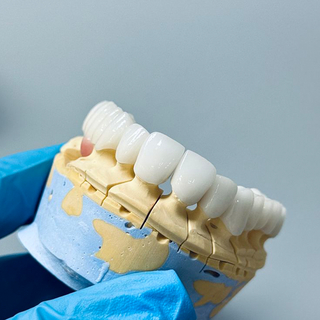Zirconia's transformation from a chalky, milled blank into a incredibly strong, glass-like monolith is one of modern dentistry's most critical processes: sintering. For the dental laboratory, sintering is not merely a step in production; it is the fundamental process that defines the final restoration's structural integrity, marginal fit, and aesthetic potential.
The Science of Sintering: What Happens in the Furnace?
Sintering is a thermal treatment that bonds powdered materials into a solid mass without melting them to the point of liquefaction. For 3Y-TZP (Yttria-stabilized Tetragonal Zirconia Polycrystal) zirconia, this process:
-
Drives Off Binders: The initial heating phase carefully burns out the organic binders used in the green-state blank.
-
Initiates Densification: As temperature increases, atomic diffusion accelerates. Particles begin to fuse at their boundaries, eliminating porosity and causing significant linear shrinkage (typically 20-25%).
-
Forms the Crystal Structure: The high-temperature hold stabilizes the fully dense tetragonal crystal structure, which is responsible for zirconia's renowned fracture toughness via transformation toughening.
Critical Parameters for a Perfect Sintering Cycle
Consistency is non-negotiable. Key furnace parameters must be meticulously controlled:
-
Final Sintering Temperature: Specific to the zirconia brand and shade. Deviating by even 50°C can drastically affect density and translucency.
-
Heating Rate: A controlled, gradual ramp is essential to allow complete binder burnout without creating internal stresses or cracks. Too fast can "crust" the surface, trapping gases.
-
Hold Time (Dwell Time): The duration at the peak temperature ensures complete densification throughout the entire restoration.
-
Cooling Rate: A controlled cool-down prevents thermal shock that can introduce micro-cracks.
The Non-Negotiables: Furnace Calibration and Maintenance
A high-quality, calibrated furnace is the lab's most crucial piece of equipment for zirconia. Regular maintenance and calibration against a thermocouple are essential. Best practices include:
-
Avoiding Overloading: Do not crowd the furnace chamber, as it disrupts air circulation and creates hot/cold spots.
-
Consistent Positioning: Always place restorations in the same central location within the furnace chamber.
-
Using a Sintering Tray: Ensures even heat distribution and catches any potential binder residue.
Conclusion
Mastering zirconia sintering is a blend of art and exact science. By respecting the material's chemistry and rigorously controlling the furnace environment, laboratories can guarantee their dentist clients restorations of unparalleled strength, precision, and reliability.

